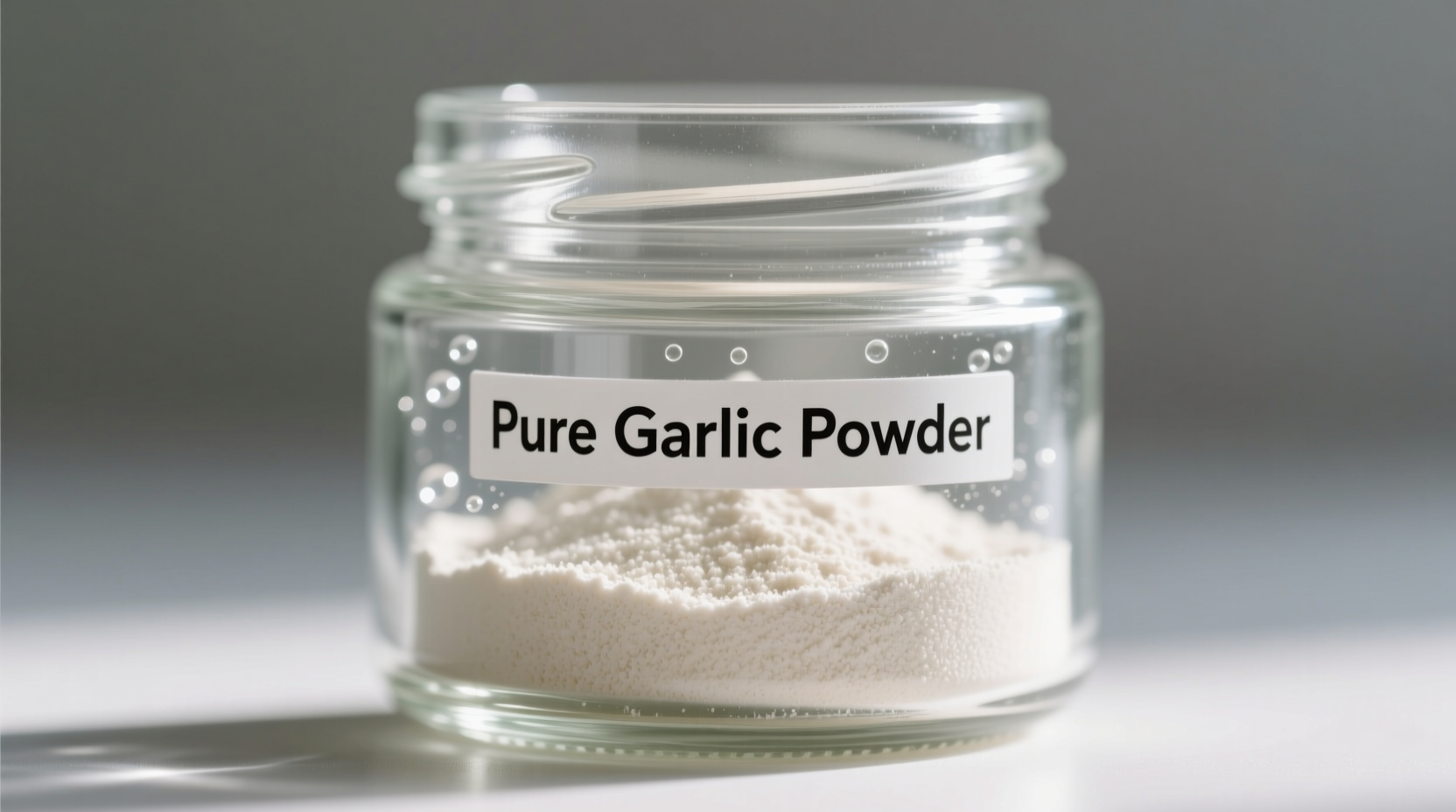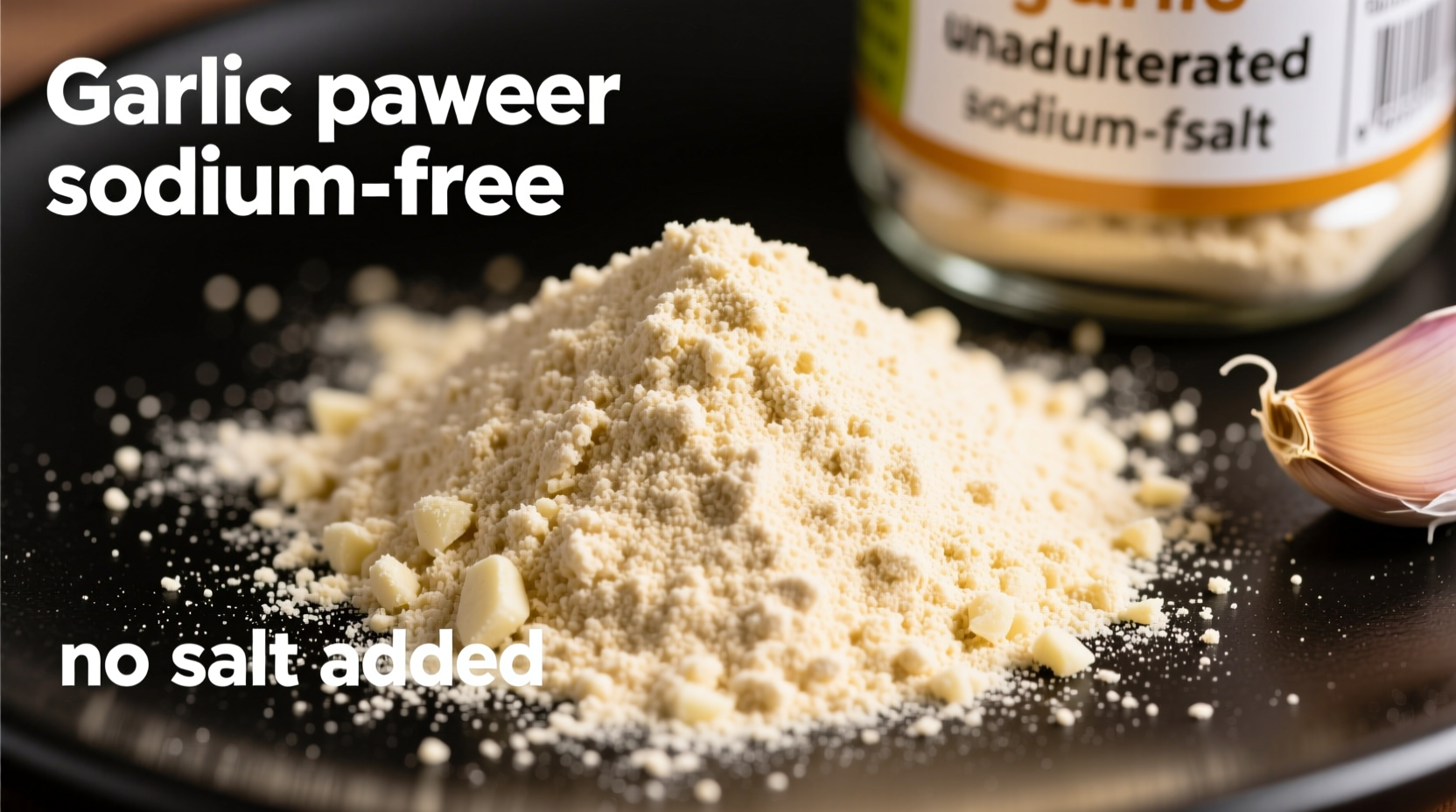What Exactly Is in Garlic Powder?
When you're monitoring sodium intake for health reasons, understanding the composition of your seasonings is crucial. Pure garlic powder consists solely of dehydrated garlic cloves ground into a fine powder. According to USDA FoodData Central, 100% pure garlic powder contains negligible sodium—approximately 10mg per 100g, which translates to nearly zero in typical usage amounts.
| Garlic Form | Sodium Content (per tsp) | Notes |
|---|---|---|
| Pure garlic powder | 0-5mg | Naturally occurring trace amounts |
| Garlic salt | 1,600mg | Approximately 40% salt by weight |
| Fresh garlic | 1mg | Naturally occurring |
| Seasoned garlic blend | Varies (100-500mg) | Check labels for additives |
This nutritional fact comes directly from the USDA FoodData Central database, the authoritative source for food composition information in the United States. The minimal sodium present occurs naturally in garlic itself, not from added salt.
Why the Confusion About Sodium in Garlic Powder?
Many consumers mistakenly believe garlic powder contains significant sodium because:
- Confusion with garlic salt – These are completely different products (garlic salt is typically 60% salt)
- Seasoned blends – Some commercial products add salt, anti-caking agents, or flavor enhancers
- Label misreading – Not checking ingredient lists thoroughly

Reading Labels Like a Pro: Finding Truly Sodium-Free Garlic Powder
When shopping for low-sodium options, follow these practical steps:
Step 1: Check the Ingredient List
Pure garlic powder should list only “garlic” or “dehydrated garlic.” Avoid products containing:
- Salt or sodium chloride
- Sodium diacetate (a common anti-caking agent)
- Monosodium glutamate (MSG)
- Sodium benzoate (a preservative)
Step 2: Examine the Nutrition Facts Panel
Look for products showing 0mg sodium per serving. Remember that FDA guidelines allow products with less than 5mg sodium per serving to list 0mg.
Step 3: Understand Serving Sizes
Garlic powder is typically used in small quantities (1/8 to 1/4 teaspoon per serving), so even products with minimal sodium remain negligible in your overall intake.
Garlic Powder in Low-Sodium Cooking: Practical Applications
As someone who's worked with both professional chefs and home cooks monitoring sodium intake, I've seen how pure garlic powder transforms low-sodium cooking:
Smart Substitution Guide
- Replace 1 clove fresh garlic = 1/8 teaspoon garlic powder
- For roasted garlic flavor = 1/4 teaspoon garlic powder + 1/8 teaspoon onion powder
- When reducing salt = Increase garlic powder by 1/16 teaspoon to compensate for flavor
Pro Tips for Maximum Flavor
Professional kitchens use these techniques to maximize garlic flavor without sodium:
- Bloom in oil – Heat 1/4 teaspoon garlic powder in 1 tsp oil for 30 seconds before adding other ingredients
- Combine with acid – Pair with lemon juice or vinegar to enhance perceived saltiness
- Add late in cooking – Preserves volatile flavor compounds that degrade with prolonged heat
Special Considerations for Health-Conscious Cooks
If you're managing hypertension or following a medically-restricted diet:
- The American Heart Association recommends no more than 1,500mg sodium daily for optimal heart health
- Pure garlic powder contributes negligibly to your sodium budget, allowing room for other flavor elements
- Be cautious with pre-made spice blends—even “Italian seasoning” often contains sodium
When I consult with cardiac rehabilitation programs, I always emphasize that pure garlic powder is one of the safest flavor enhancers for strict low-sodium protocols. The natural organosulfur compounds in garlic actually support cardiovascular health through different mechanisms than sodium reduction.
Frequently Asked Questions
Does garlic powder naturally contain sodium?
Pure garlic powder contains only trace amounts of naturally occurring sodium (0-5mg per teaspoon), which is nutritionally insignificant. This minimal sodium comes from the garlic itself, not added salt.
How can I tell if my garlic powder has added sodium?
Check the ingredient list for any mention of salt, sodium chloride, or sodium-containing additives. Pure garlic powder should list only “garlic” as the ingredient. Also verify the nutrition facts panel shows 0mg sodium per serving.
Is garlic powder a good substitute for garlic salt in low-sodium diets?
Yes, pure garlic powder makes an excellent substitute. Use 1/4 teaspoon garlic powder plus 1/4 teaspoon onion powder to replace 1/4 teaspoon garlic salt. You'll get similar flavor complexity without the 1,600mg of sodium found in garlic salt.
Does the sodium content differ between brands of pure garlic powder?
For 100% pure garlic powder with no additives, sodium content is virtually identical across brands (0-5mg per teaspoon) because it comes from the natural composition of garlic. Differences only appear when manufacturers add salt or sodium-containing preservatives.











 浙公网安备
33010002000092号
浙公网安备
33010002000092号 浙B2-20120091-4
浙B2-20120091-4